Developer Guide
- Setting up, getting started
- Design
- Implementation
- Documentation, logging, testing, configuration, dev-ops
- Appendix: Requirements
- Appendix: Instructions for manual testing
- Appendix: Effort
Setting up, getting started
Refer to the guide to set up the project in your computer using an Integrated Development Environment (IntelliJ is highly recommended) Setting up and getting started.
Design
The different components and sub-components of Common Cents and how they interact with each other.
Architecture
The Architecture Diagram given above explains the high-level design of the App. Given below is a quick overview of each component.

.puml files used to create diagrams in this document can be found in the diagrams folder. Refer to the PlantUML Tutorial at se-edu/guides to learn how to create and edit diagrams.
Main has two classes called Main and MainApp. It is responsible for,
- At app launch: Initializes the components in the correct sequence, and connects them up with each other.
- At shut down: Shuts down the components and invokes cleanup methods where necessary.
Commons represents a collection of classes used by multiple other components.
The rest of the App consists of four components.
-
UI: The UI of the App. -
Logic: The command executor. -
Model: Holds the data of the App in memory. -
Storage: Reads data from, and writes data to, the hard disk.
Each of the four components,
- defines its API in an
interfacewith the same name as the Component. - exposes its functionality using a concrete
{Component Name}Managerclass (which implements the corresponding APIinterfacementioned in the previous point.
For example, the Logic component (see the class diagram given below) defines its API in the Logic.java interface and exposes its functionality using the LogicManager.java class which implements the Logic interface.

How the architecture components interact with each other
The Sequence Diagram below shows how the components interact with each other for the scenario where the user issues the command delete 1 c/expense.

The sections below give more details of each component.
UI component
The UI component represents elements directly interacting with the user.

API: The UI consists of a MainWindow that is made up of parts e.g.CommandBox, ResultDisplay, AccountListPanel, StatusBarFooter etc. All these, including the MainWindow, inherit from the abstract UiPart class.
The UI component uses JavaFx UI framework. The layout of these UI parts are defined in matching .fxml files that are in the src/main/resources/view folder. For example, the layout of the MainWindow is specified in MainWindow.fxml
The UI component,
- Executes user commands using the
Logiccomponent. - Listens for changes to
Modeldata so that the UI can be updated with the modified data.
Logic component
The Logic component parses and executes the commands.

API :
Logic.java
-
Logicuses theCommonCentsParserclass to parse the user command. - This results in a
Commandobject which is executed by theLogicManager. - The command execution can either affect the
ActiveAccountwhich in turn affects theModel(e.g. adding an expense), or affect theModeldirectly (e.g. adding an account). - Based on the changes the command execution made, the
CommandResultFactorygenerates aCommandResultobject which encapsulates the result of the command execution and is passed back to theUi.
- In addition, the
CommandResultobject can also instruct theUito perform certain actions, such as displaying help to the user.
Given below is the Sequence Diagram for interactions within the Logic component for the execute("deleteacc 1") API call.
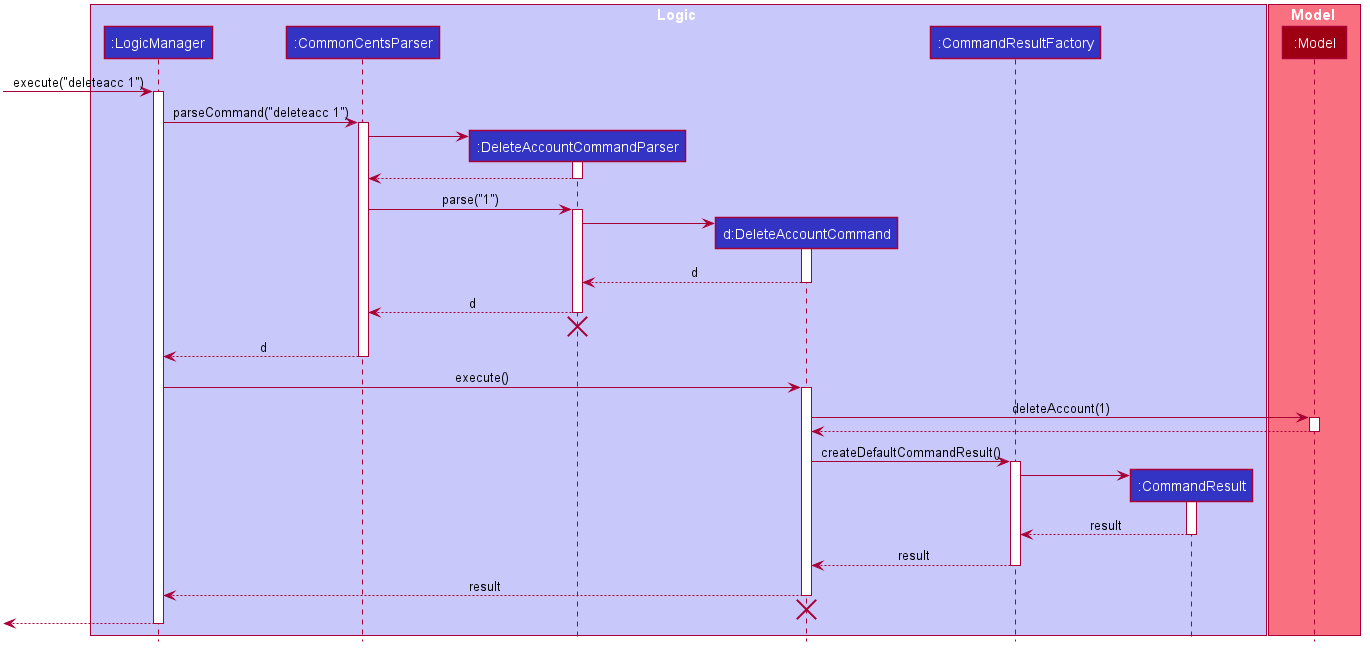
DeleteAccountCommandParser, DeleteAccountCommand and CommandResultFactory should end at the destroy marker (X) but due to a limitation of PlantUML, their lifeline reach the end of diagram.
Model component
The model component stores the relevant data for Common Cents. The model component consist of two key aspects, the Model and the ActiveAccount.

API : Model.java, ActiveAccount.java
The Model,
- responsible for managing the data of Common Cents which holds all the accounts.
- stores a
UserPrefobject that represents the user’s preferences. - stores the CommonCents data.
- stores an unmodifiable list of Accounts.
- does not depend on any of the other three components.
The ActiveAccount,
- responsible for managing the data of the currently active Account.
- stores a
Accountobject that represents the current Account that the user is managing. - stores an
ObservableList<Expense>that can beobservede.g. the UI can be bounde to this list so that the UI automatically updates when the data in the list change. - stores an
ObservableList<Revenue>that can beobservede.g. the UI can be bounde to this list so that the UI automatically updates when the data in the list change. - stores an
Optional<ActiveAccount>that represents the previous state of theActiveAccount. - does not depend on any of the other four components.
Tag list in the CommonCents, which Entry references. This allows CommonCents to only require one Tag object per unique Tag, instead of each Entry needing their own Tag object.
Storage component
The Storage component deals with save and load user data.

API : Storage.java
The Storage component,
- can save
UserPrefobjects in json format and read it back. - can save the CommonCents data in json format and read it back.
Common classes
Classes used by multiple components are in the seedu.cc.commons package.
Implementation
This section describes some noteworthy details on how certain features are implemented.
Add entries feature
(Written by Nicholas Canete)
This feature allows user to add entries to an account.
Implementation
The proposed add entries feature is facilitated by AddCommand. It extends Command and
is identified by CommonCentsParser and AddCommandParser. The AddCommand interacts
with Account and the interactions are managed by ActiveAccount. As such, it implements the following
operations:
-
Account#addExpense(Expense entry)andAccount#addRevenue(Revenue entry)— Adds the specified revenue or expense entries into the Revenue or Expense list of the current account. list to the specified edited expense -
Model#setAccount(Account editedAccount)— Sets the current account in the model as the specified edited account after adding an Entry
The operations are exposed in the ActiveAccount interface as ActiveAccount#addExpense
and ActiveAccount#addRevenue, and in Model as Model#setAccount.
Given below is an example usage scenario and how the find entries mechanism behaves at each step.
-
Step 1. The user inputs the edit command to edit the entries of a specified index and entry type (Expense or Revenue) from current
ActiveAccount.CommandParseridentifies the command wordeditand callsAddCommandParser#parse(String args)to parse the input into a validAddCommand. It will check for compulsory category (to specify whether the entry is an expense or revenue), description and amount, as well as optional tags. It will use these fields to create an Entry object to be used in theAddCommandconstructor. -
Step 2.
AddCommandstarts to be executed. In the execution,- The added Entry will go through a condition check whether it is a Revenue or Expense.
It will call
ActiveAccount#addRevenueorActiveAccount#addExpenseaccordingly - It will call on both
ActiveAccount.updateFilteredExpenseList(PREDICATE_SHOW_ALL_EXPENSES)andActiveAccount.updateFilteredRevenueList(PREDICATE_SHOW_ALL_REVENUE)to update the User Interface after adding the new Entry. - It will update the current account by calling
Model#setAccount.
- The added Entry will go through a condition check whether it is a Revenue or Expense.
It will call
The following sequence diagram shows how add entry operation works:
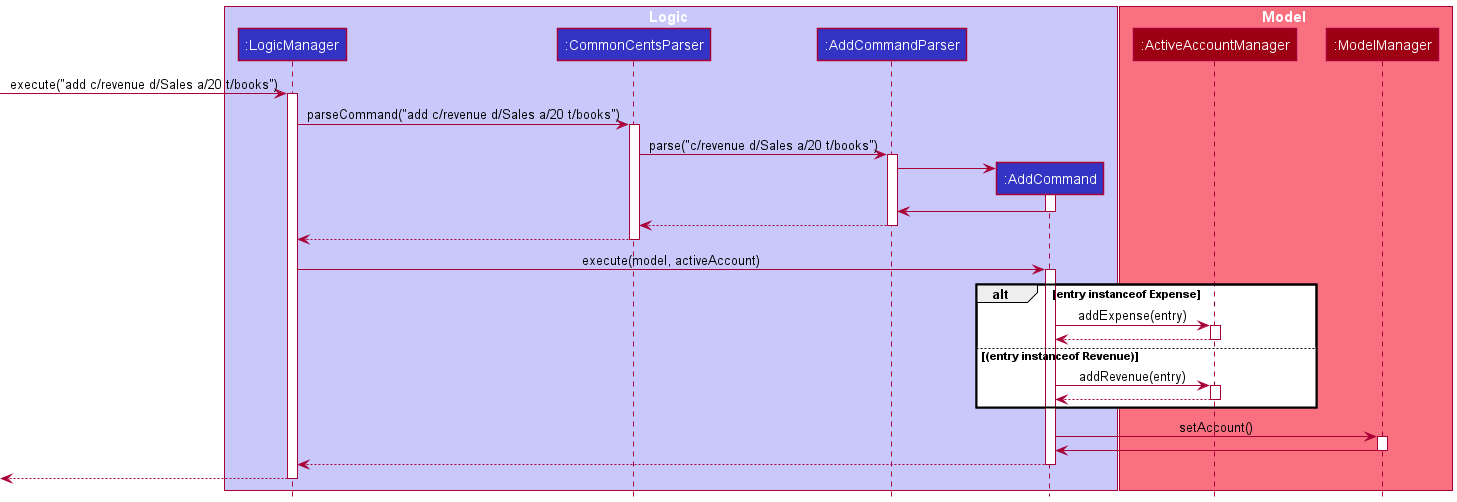
CommandResult and Storage are left out of the sequence diagram as their roles are not significant in the execution
of the edit entries command.
The following activity diagram summarizes what happens when a user executes a new command:
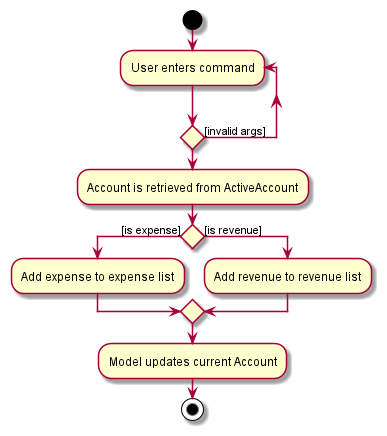
Delete feature
(Written by Jordan Yoong)
This feature allows the user to delete previously added entries from an account.
Implementation
The delete entries feature is facilitated by DeleteCommand. It extends Command and
is identified by CommonCentsParser and DeleteCommandParser. The DeleteCommand interacts
with Account and the interactions are managed by ActiveAccount. As such, it implements the following
operations:
-
Account#deleteExpense(Expense expense)— Executes delete logic for specified Expense entry. -
Account#deleteRevenue(Revenue revenue)— Executes delete logic for specified Revenue entry.
Given below is an example usage scenario and how the delete mechanism behaves at each step.
-
Step 1: The user inputs the delete command to specify which entry to delete in the specified category of
ActiveAccount.CommandParseridentifies the command worddeleteand callsDeleteCommandParser#parse(String args)to parse the input into a validDeleteCommand. -
Step 2:
DeleteCommandstarts to be executed. In the execution:- If the user input for category matches that of the Expense keyword, the entry matching the specified index in the Expense List will be removed.
- If the user input for category matches that of the Revenue keyword, the entry matching the specified index in the Revenue List will be removed.
The following sequence diagram shows how a delete entry operation works:

CommandResult and Storage are left out of the sequence diagram as their roles are not significant in the execution
of the delete entries command.
The following activity diagram summarizes what happens when a user executes a new command:

Design consideration
Explanation why a certain design is chosen.
Aspect: How delete entries command is parsed
-
Choice: User needs to use prefixes before the keywords.
- Pros:
- Easy to implement as the arguments can be tokenized in the event of inputs with multiple arguments.
- Allows Parser to filter out invalid commands
- Cons: Less convenience for the user.
- Pros:
Edit entries feature
(Written by Nicholas Canete)
This feature allows the user to edit existing entries.
Implementation
The proposed edit entries feature is facilitated by EditCommand. It extends Command and
is identified by CommonCentsParser and EditCommandParser. The EditCommand interacts
with Account and the interactions are managed by ActiveAccount. As such, it implements the following
operations:
-
Account#setExpense(Expense target, Expense editedExpense)— Sets the target expense in the expense list to the specified edited expense -
Account#setRevenue(Revenue target, Revenue editedRevenue)— Sets the target revenue in the revenue list to the specified edited revenue -
Model#setAccount(Account editedAccount)— Sets the current account in the model as the specified edited account
The operations are exposed in the ActiveAccount interface as ActiveAccount#setExpense and
ActiveAccount#setRevenue, and in Model as Model#setAccount.
Given below is an example usage scenario and how the find entries mechanism behaves at each step.
-
Step 1. The user inputs the edit command to edit the entries of a specified index and entry type (Expense or Revenue) from current
ActiveAccount.CommandParseridentifies the command wordeditand callsEditCommandParser#parse(String args)to parse the input into a validEditCommand. It will check for the desired index, a compulsory category (expense or revenue) and optional fields (e.g. description, amount, tags) to create anEditEntryDescriptor, a static class to help create newEntryobjects to edit existing ones. -
Step 2.
EditCommandstarts to be executed. In the execution,- The index of the desired entry to edit will be checked against the revenue list or expense list to see if that index is valid (i.e. within the size of the specified list) and nonzero positive integer
- It will use the parsed fields from Step 1 above to create a new
RevenueorExpenseobject to edit a pre-existing one according to the specified index and Category. - It will call on
ActiveAccount#setRevenueorActiveAccount#setExpenseto modify the specifiedExpenseorRevenueand update the current account by callingModel#setAccount.
The following sequence diagram shows how edit entry operation works:

CommandResult and Storage are left out of the sequence diagram as their roles are not significant in the execution
of the edit entries command.
The following activity diagram summarizes what happens when a user executes a new command:
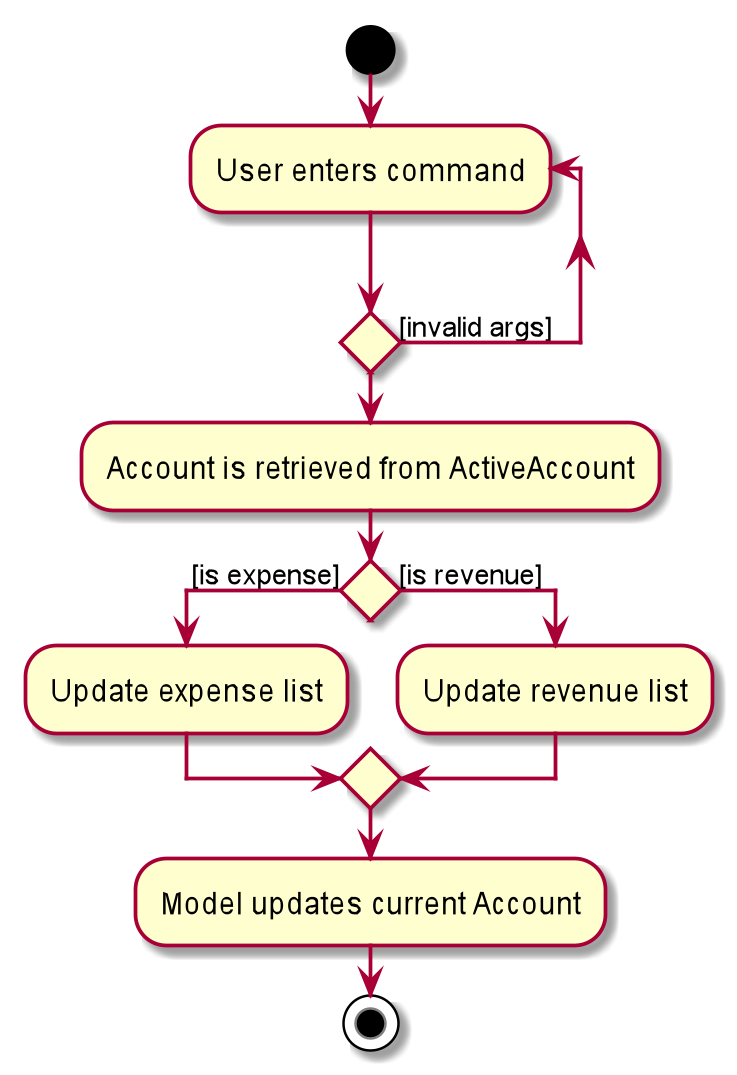
Design consideration:
Aspect: Specifying indexes to edit
-
Choice: User needs to specify a category “c/expense” or “c/revenue” instead of just
specifying index and edited fields alone.
- Pros:
- Easy to implement and can specifically target whether edits want to be made in the revenue list or expense list
- Indexes easier to follow, just follow the numbers from the User Interface
- Cons: Less convenience for the user, as more typing needs to be done.
- Pros:
Clear feature
(Written by Jordan Yoong)
This feature allows the user to clear previously added entries.
Implementation
The clear entries feature is facilitated by ClearCommand. It extends Command and
is identified by CommonCentsParser and ClearCommandParser. The ClearCommand interacts
with Account and the interactions are managed by ActiveAccount. As such, it implements the following
operations:
-
Account#clearExpenses()— Executes clear all entries logic in Expense category. -
Account#clearRevenues()— Executes clear all entries logic in Revenue category.
Given below is an example usage scenario and how the clear command mechanism behaves at each step.
- Step 1: The user inputs the clear command to specify which category it wants to clear in either lists
of
ActiveAccount.CommandParseridentifies the command wordclearand callsClearCommandParser#parse(String args)to parse the input into a validClearCommand.
- Step 2:
ClearCommandstarts to be executed. In the execution:- If user input does not specify a category, both Expense and Revenue Lists will be cleared.
- If the user input for category matches that of the Expense keyword, Expense List will be cleared.
- If the user input for category matches that of the Revenue keyword, Revenue List will be cleared.
The following sequence diagram shows how a clear entry operation works:
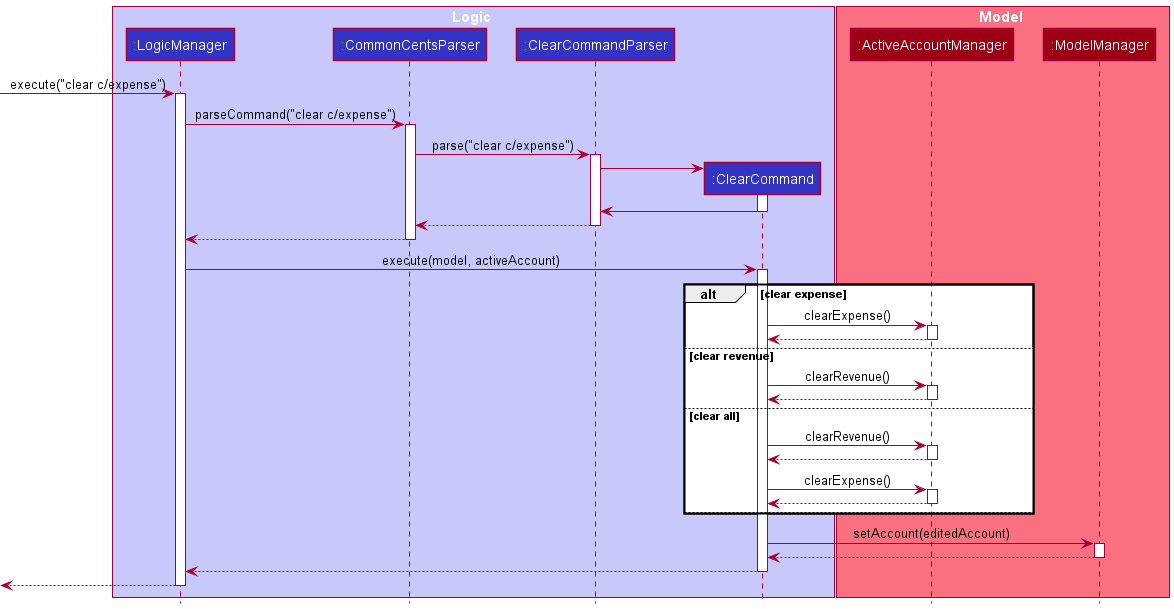
CommandResult and Storage are left out of the sequence diagram as their roles are not significant in the execution
of the clear entries command.
The following activity diagram summarizes what happens when a user executes a new command:
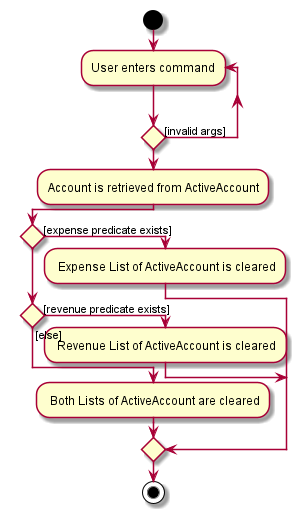
![]() Note: Due to PlantUML limitations, the else condition overlaps with a frame.
Note: Due to PlantUML limitations, the else condition overlaps with a frame.
Design consideration
Explanation why a certain design is chosen.
Aspect: How clear entries command is parsed
-
Choice: User needs to use prefixes before the keywords.
- Pros:
- Easy to implement as the arguments can be tokenized
- Allows Parser to filter out invalid commands
- Cons: Less convenience for the user.
- Pros:
Undo feature
(Written by Lim Zi Yang)
This feature allows the user to undo their previous entry-level commands.
Implementation
The undo mechanism is facilitated by UndoCommand, which extends Command and is identified by CommonCentsParser.
The UndoCommand interacts with ActiveAccount using methods in ActiveAccount. As such, it implements the following operations:
-
ActiveAccount#setPreviousState()— Saves a copy of the currentActiveAccountstate as an attribute inActiveAccount. -
ActiveAccount#returnToPreviousState()— Restores the previousActiveAccountstate from its attribute.
Given below is an example usage scenario and how the undo mechanism behaves at each step. Note that each step starts with an explanation followed by a diagram.
- Step 1. When the user first runs Common Cents,
ActiveAccountdoes not store any previous states as shown in the diagram below.
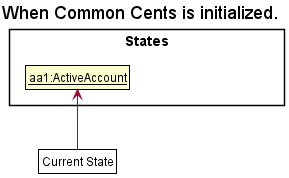
- Step 2. The user executes
delete 5 c/expensecommand to delete the 5th expense in the expense list inActiveAccount. Thedeletecommand callsActiveAccount#setPreviousState()initially, causing a copy of theActiveAccountstate before thedelete 5 c/expensecommand executes to be saved as an attribute. After this, thedelete 5 c/expensecommand executes and the model is updated according to the modifiedActiveAccount.
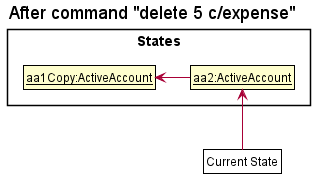
ActiveAccount#setPreviousState(), so the state will not be saved into its attribute.
- Step 3. The user now decides that deleting the expense was a mistake, and decides to undo that action by executing the
undocommand. Theundocommand will callActiveAccount#returnToPreviousState(), which will set data of the previous state attribute to the currentActiveAccount.
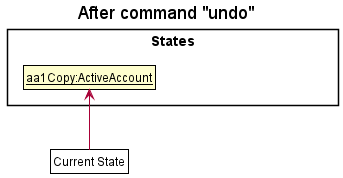
ActiveAccount does not have a previous state
(i.e The previousState attribute in ActiveAccount is empty) then there are no previous ActiveAccount states to restore.
The undo command uses ActiveAccount#hasNoPreviousState() to check if this is the case. If so, it will return an error to the user rather
than attempting to perform the undo.
The following sequence diagram shows how the undo operation works:


![]() Note::
Note::
- The reference diagram should have a notation on the top left of the diagram but due to a limitation of PlantUML, the notation is represented by a title instead.
- The lifeline for
UndoCommandshould end at the destroy marker (X) but due to a limitation of PlantUML, the lifeline reaches the end of diagram. - Some of the interactions with the utility classes, such as
CommandResultandStorageare left out of the sequence diagram as their roles are not significant in the execution of the undo command.
The following activity diagram summarizes what happens when a user executes a new command:

ActiveAccount#setPreviousState() is only called in add, delete, edit, and clear commands.
Hence, the undo command only works on the previously stated entry-level commands.
Design consideration
Explanation why a certain design is chosen.
Aspect: How undo executes
-
Alternative 1 (current choice): Saves the entire ActiveAccount.
- Pros: Easy to implement.
- Cons:
- May have performance issues in terms of memory usage.
- Only allow undo command to work for commands dealing with entries.
-
Alternative 2: Saves the entire Model and ActiveAccount
- Pros: More commands can be undone, for instance commands dealing with accounts.
- Cons:
- May have performance issues in terms of memory usage.
- We must ensure that the implementation avoids unnecessary changes to Model or ActiveAccount that can result in bugs.
-
Alternative 3: Individual command knows how to undo by itself.
- Pros: Will use less memory (e.g. for
delete, just save the entry being deleted). - Cons: We must ensure that the implementation of each individual command are correct.
- Pros: Will use less memory (e.g. for
Edit account feature
(Written by Lim Zi Yang)
This feature allows the user to edit the information of a specific existing entry.
Implementation
The proposed edit account mechanism is facilitated by EditAccountCommand. It extends Command and is identified by
CommonCentsParser and EditAccountCommandParser. The EditAccountCommand interacts with Account and the interaction
is managed by ActiveAccount as well as the Model. As such, it implements the following operation:
-
Account#setName(Name editedName)— Sets the name of the account
This operation is exposed in the ActiveAccount interface as ActiveAccount#setName().
Given below is an example usage scenario and how the edit account mechanism behaves at each step.
-
Step 1: The user inputs the edit account command to edit the current account in
ActiveAccount.CommonCentsParseridentifies the command word and callsEditCommandParser#parse(String args)to parse the input into a validEditAccountCommand -
Step 2:
EditAccountCommandstarts to be executed. In its execution, the current account, namelypreviousAccountinActiveAccountis retrieved. -
Step 3:
ActiveAccount#setName(Name editedName)is called with the edited name to replace the name of the current account inActiveAccount. -
Step 4: The updated account, namely
newAccount, inActiveAccountis retrieved. -
Step 5:
Model#setAccount(Account target, Account editedAccount)is called withpreviousAccountastarget, andnewAccountaseditedAccount. This is to replace the to-be-edited account in the Model with the edited account.
The following sequence diagram shows how an edit account operation works:
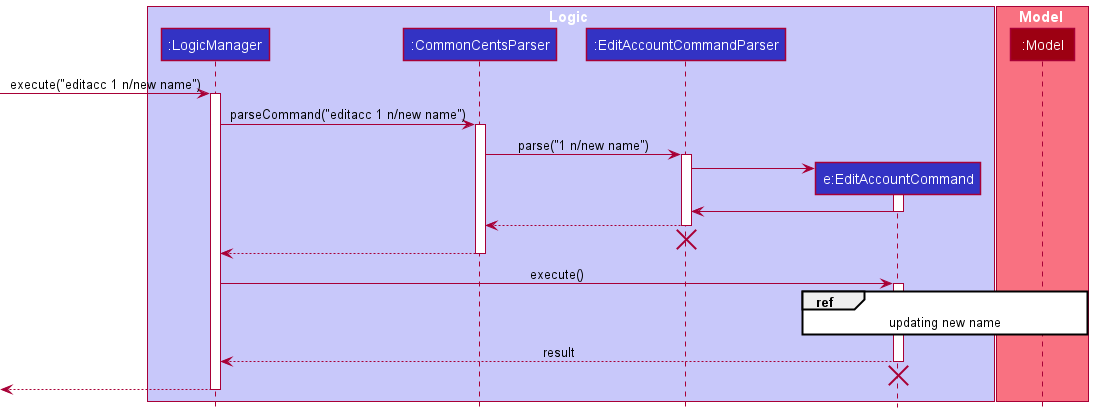
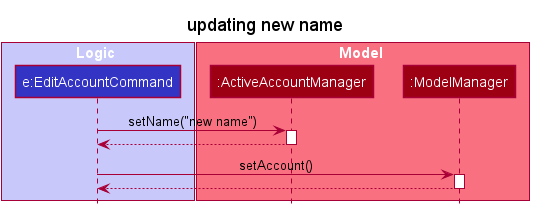
![]() Note:
Note:
- The reference diagram should have a notation on the top left of the diagram but due to a limitation of PlantUML, the notation is represented by a title instead.
- The lifeline for
EditAccountCommandParserandEditAccountCommandshould end at the destroy marker (X) but due to a limitation of PlantUML, their lifeline reach the end of diagram. - Some of the interactions with the utility classes, such as
CommandResultandStorageare left out of the sequence diagram as their roles are not significant in the execution of the edit account command.
The following activity diagram summarizes what happens when a user executes a new command:
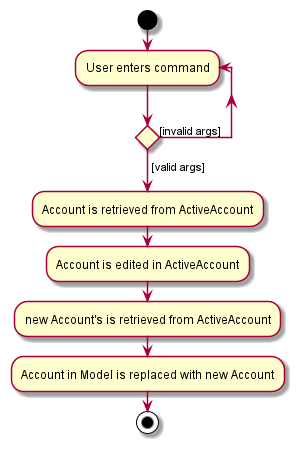
Design consideration
Explanation why a certain design is chosen.
Aspect: How edit account executes
-
Alternative 1 (current choice): Accounts can only be edited if they are active.
- Pros: Easy to implement.
- Cons: Less flexibility for user.
-
Alternative 2: Accounts can be edited by retrieving them from the account list with an index input.
- Pros: More flexibility for user.
- Cons: It is difficult to implement and manage because we need to consider whether the account to be edited is active and add extra measures for that case. As such, we chose alternative one since it is a more elegant solution.
Aspect: Mutability of account
-
Choice: Allowing name attribute of Account to be mutated by EditCommand.
- Rationale: Initially, the name attribute of Account was implemented to be immutable. However, it is difficult to edit the name of the account if it is immutable. Hence, to overcome this obstacle,name attribute was made mutable.
- Implications: Extra precautions needed to be implemented, for instance creating copies of account in methods that interacts with the accounts to prevent unnecessary changes to accounts in account list. Hence, it resulted in more defensive coding which resulted in more lines of code.
Find entries feature
(Written by Le Hue Man)
This feature allows the user to find specific existing entries using a given keyword.
Implementation
The Find entries feature is facilitated by FindCommand. It extends Command and
is identified by CommonCentsParser and FindCommandParser. The FindCommand interacts
with Account and the interactions are managed by ActiveAccount. As such, it implements the following
operations:
-
Account#updateFilteredExpenseList(Predicate<Expense> predicate)— Updates the expense list that has the given keywords as predicate. -
Account#updateFilteredRevenueList(Predicate<Revenue> predicate)— Updates the revenue list that has the given keywords as predicate.
Given below is an example usage scenario and how the find entries mechanism behaves at each step.
-
Step 1. The user inputs the find command to find the entries that have the occurrences of a list of specified keywords in the entries of
ActiveAccount.CommandParseridentifies the command wordfindand callsFindCommandParser#parse(String args)to parse the input into a validFindCommand. -
Step 2.
FindCommandstarts to be executed. In the execution,- If there is a predicate for keywords in the expense list of
ActiveAccount, the expense list is updated.ActiveAccount#updateFilteredExpenseList()is called to update the current expense list with expenses with descriptions matching the keywords. - If there is a predicate for keywords in the revenue list of
ActiveAccount, the revenue list is updated.ActiveAccount#updateFilteredExpenseList()is called to update the current revenue list with revenues with descriptions matching the keywords.
- If there is a predicate for keywords in the expense list of
The following sequence diagram shows how a find entry operation works:

CommandResult and Storage are left out of the sequence diagram as their roles are not significant in the execution
of the find entries command.
The following activity diagram summarizes what happens when a user executes a new command:
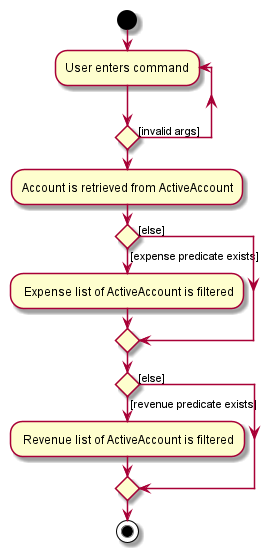
Design consideration
Explanation why a certain design is chosen.
Aspect: How find entries command is parsed
-
Choice: User needs to use prefix “k/” to before the keywords.
- Pros:
- Easy to implement as the arguments can be tokenized in the event of inputs with multiple arguments.
- Able to handle multiple arguments as input for Category (with prefix “c/”) is optional.
- Cons: Less convenience for the user.
- Pros:
Calculate net profits feature
(Written by Cheok Su Anne)
This feature allows the user to calculate and view profits made in an account.
Implementation
The calculate net profits mechanism is facilitated by GetProfitCommand. It extends Command and is identified by CommonCentsParser. The GetProfitCommand interacts with Account and the interaction is managed by ActiveAccount. As such, it implements the following operations:
-
Account#getProfits()— gets the net profit from the total expenses and revenues in the account -
Account#getTotalExpenses()— gets the total sum of all the expenses in the account -
Account#getTotalRevenue()— gets the total sum of all the revenues in the account
The operation is exposed in the ActiveAccount interface as ActiveAccount#getProfits().
Given below is an example usage scenario and how the calculate net profits mechanism behaves at each step.
-
Step 1. The user inputs the profit command to calculate the net profits in the current account in ActiveAccount.
CommonCentsParseridentifies the command word and calls a validGetProfitCommand. -
Step 2.
GetProfitCommandstarts to be executed. In the execution,ActiveAccount#getProfits()is called to calculate the net profits.-
Account#getTotalExpense()andAccount#getTotalRevenue()are called inActiveAccount#getProfitsto get the total expenses and total revenues. The net profit is then calculated by subtracting the difference.
-
The following sequence diagram shows how a calculate net profits operation works:

![]() Note::
Note::
- The lifeline for
GetProfitCommandshould end at the destroy marker (X) but due to a limitation of PlantUML, the lifeline reaches the end of diagram. - Some of the interactions with the utility classes, such as
CommandResult,CommandResultFactoryandStorageare left out of the sequence diagram as their roles are not significant in the execution of the get profit command.
The following activity diagram summarizes what happens when a user executes a new command:
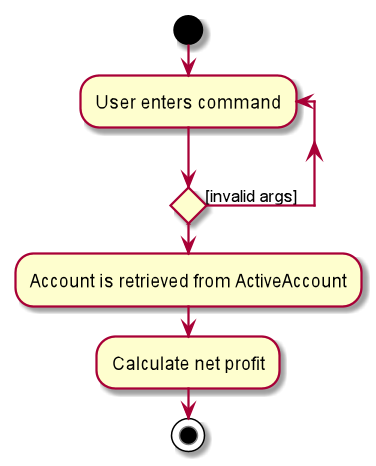
Design consideration
Explanation why a certain design is chosen.
Aspect: How calculate net profits executes
-
Choice: Calculates the net profits by retrieving the expense and revenue lists from the account.
- Pros: Easy to implement
Documentation, logging, testing, configuration, dev-ops
This section includes the guides for developers to reference.
Appendix: Requirements
This includes the different functional as well as non-functional requirements of Common Cents.
Product scope
This section highlights the problems that Common Cents solves by describing the target user profile and value proposition of the app.
Target user profile:
- Has a need to manage a significant number of business accounts, each with a significant number of financial entries
- Prefers desktop apps over other types
- Can type fast
- Prefers typing to mouse interactions
- Is reasonably comfortable using CLI apps
Value proposition:
- Can manage financial entries faster than a typical mouse/GUI driven app
- Provides a simple UI for business owners to see all the desired information easily
- Provides an aesthetic UI which is pleasant to the eye
User stories
This section describes the features of Common Cents from an end-user perspective.
![]() Note:
Note:
Priorities are represented by the number of *:
- High (must have) -
* * * - Medium (nice to have) -
* * - Low (unlikely to have) -
*
| Priority | As a … | I want to … | So that I can… |
|---|---|---|---|
* * * |
user | be able to exit the app | |
* * * |
user | be able to add my expense/revenue entries to the userboard | |
* * * |
user | be able to delete my expense/revenue entries from the userboard | |
* * * |
user | view my expenditure by category | |
* * * |
new user | be able to view a help FAQ on the functionality of the program | navigate through the different aspects of it |
* * * |
user | be able to save my tasks and load them when the app is re-opened | |
* * * |
user with many side businesses | keep my accounts and expenses separate | understand where my inflow and outflow of finances come from |
* * * |
user | have my expenses/revenues be calculated on demand | |
* * * |
clumsy user | be able to edit my expenses/revenues | fix wrongly keyed-in information |
* * * |
user | be able to find specific expenses/revenues | check for its specific information |
* * * |
user | be able to view my net profits on the userboard | |
* * * |
clumsy user | be able to undo my commands | to reverse unwanted/wrong commands |
* * * |
fast typist | be able to maximize my typing speed | |
* * * |
user | have commands that are short but as intuitive as possible | |
* * |
user who as an eye for aesthetics | have an app that is elegant and visually appealing | be motivated to use the app more |
* * |
user | have an app that is intuitive and easy to use | easily navigate through it |
* * |
user with limited time | have an app that is user friendly and efficient | save time |
* * |
user | be able to use the app in dark mode | protect my eyesight |
* * |
user | have an incentive every time I use the app (maybe a little game or puzzle) | be motivated to use it to track my spending more |
* * |
user | have an app that caters specifically to different types of accounts (business or personal) | efficiently manage my expenses and revenues |
* |
user | be given tips and tricks on how to use the app to plan my spending | save my money effectively |
Use cases
This captures different scenarios of how a user will perform tasks while using Common Cents.
For all use cases below, the System is the CommonCents and the Actor is the user, unless specified otherwise.
Use Case: UC01 - Adding an expense
MSS
- User requests to add an expense.
-
Common Cents adds the expense to expense list and displays success message.
Use case ends.
Extensions
-
1a. The given command input is in invalid format.
-
1a1. Common Cents shows an error message.
Use case resumes at step 1.
-
Use Case: UC02 - Adding a revenue
MSS
- User requests to add revenue.
-
Common Cents adds revenue to revenue list and displays success message.
Use case ends.
Extensions
-
1a. The given command input is in invalid format.
-
1a1. Common Cents shows an error message.
Use case resumes at step 1.
-
Use Case: UC03 - Deleting an expense
MSS
- User requests to delete an expense.
-
Common cents deletes the expense.
Use case ends.
Extensions
-
1a. The given command input is in invalid format.
-
1a1. Common cents shows an error message.
Use case resumes at step 1.
-
Use Case: UC04 - Deleting a revenue
MSS
- User requests to delete an revenue.
-
Common Cents removes the revenue from the revenue list and displays success message.
Use case ends.
Extensions
-
1a. The given command input is in invalid format.
-
1a1. Common cents shows an error message.
Use case resumes at step 1.
-
Use Case: UC05 - Editing an expense
MSS
- User requests to edit an expense entry.
-
Common Cents edits the supplied parameters the expense entry in the expense list and displays success message.
Use case ends.
Extensions
-
1a. The given command input is in invalid format.
-
1a1. Common cents shows an error message.
Use case resumes at step 1.
-
Use Case: UC06 - Editing a revenue
MSS
- User requests to edit a revenue entry.
-
Common Cents edits the supplied parameters the revenue entry in the revenue list and displays success message.
Use case ends.
Extensions
-
1a. The given command input is in invalid format.
-
1a1. Common cents shows an error message.
Use case resumes at step 1.
-
Use Case: UC07 - Clearing all expense entries
MSS
- User requests to clear all entries in expense list.
-
Common Cents clears all expense entries in the expense list and displays success message.
Use case ends.
Extensions
-
1a. The given command input is in invalid format.
-
1a1. Common cents shows an error message.
Use case resumes at step 1.
-
Use Case: UC08 - Clearing all revenue entries
MSS
- User requests to clear all entries in revenue list.
-
Common Cents clears all expense entries in the revenue list and displays success message.
Use case ends.
Extensions
-
1a. The given command input is in invalid format.
-
1a1. Common cents shows an error message.
Use case resumes at step 1.
-
Use Case: UC09 - Undoing an add command
MSS
- User requests add an expense (UC01).
- User requests to undo command.
- Common Cents returns to the state prior to the add command and displays success message.
Use Case: UC10 - Undoing a delete command
MSS
- User requests delete an expense (UC03).
- User requests to undo command.
- Common Cents returns to the state prior to the delete command and displays success message.
Use Case: UC11 - Undoing an edit command
MSS
- User requests edit an expense (UC05).
- User requests to undo command.
- Common Cents returns to the state prior to the edit command and displays success message.
Use Case: UC12 - Undoing a clear all expenses command
MSS
- User requests to clear all expenses (UC07).
- User requests to undo command.
- Common Cents returns to the state prior to the clear expenses command and displays success message.
Use Case: UC13 - Undoing a clear all revenues command
MSS
- User requests to clear all revenues (UC08).
- User requests to undo command.
- Common Cents returns to the state prior to the clear revenues command and displays success message.
Use Case: UC14 - Finding specific expenses
MSS
- User requests to find some specific expenses by giving keywords.
-
Common Cents filters the expense list to show the required expenses and displays success message.
Use case ends.
Extensions
-
1a. The given command input is in invalid format.
-
1a1. Common Cents shows an error message.
Use case resumes at step 1.
-
-
1b. User does not input a keyword or a list of keywords.
-
1b1. Common Cents shows an error message.
Use case resumes at step 1.
-
-
1c. User inputs a keyword or a list of keywords that do not exist in any of the expenses’ description.
-
1c1. Common Cents shows an empty expense list and displays a message to inform user that no expense is found.
Use case resumes at step 1.
-
Use Case: UC15 - Finding specific revenues
MSS
- User requests to find some specific revenues by giving keywords.
-
Common Cents filters the revenue list to show the required revenues and displays success message.
Use case ends.
Extensions
-
1a. The given command input is in invalid format.
-
1a1. Common Cents shows an error message.
Use case resumes at step 1.
-
-
1b. User does not input a keyword or a list of keywords.
-
1b1. Common Cents shows an error message.
Use case resumes at step 1.
-
-
1c. User inputs a keyword or a list of keywords that do not exist in any of the revenues’ description.
-
1c1. Common Cents shows an empty revenue list and displays a message to inform user that no revenue is found.
Use case resumes at step 1.
-
Use Case: UC16 - Finding specific entries (either expenses or revenues)
MSS
- User requests to find some specific entries by giving keywords.
-
Common Cents filters both expense and revenue lists to show the required entries and displays success message.
Use case ends.
Extensions
-
1a. The given command input is in invalid format.
-
1a1. Common Cents shows an error message.
Use case resumes at step 1.
-
-
1b. User does not input a keyword or a list of keywords.
-
1b1. Common Cents shows an error message.
Use case resumes at step 1.
-
-
1c. User inputs a keyword or a list of keywords that do not exist in any of the entries’ description.
-
1c1. Common Cents shows an empty expense and revenue lists and displays a message to inform user that no expense is found.
Use case resumes at step 1.
-
Use Case: UC17 - Calculate total profits
MSS
- User requests to calculate profits at current state.
-
Common Cents calculates profits by finding the difference between revenues and expense and returns profit amount as a message.
Use case ends.
Use Case: UC18 - List all entries
MSS
- User requests to find some specific entries (UC16).
- User requests to list all entries.
-
Commmon Cents displays all entries again before find command was used.
Use case ends.
Use Case: UC19 - Adding an account
MSS
- User request to add a new account.
-
Common Cents adds account to account list and displays success message.
Use case ends.
Extensions
-
1a. The given command input is in invalid format.
-
1a1. Common Cents shows an error message.
Use case resumes at step 1.
-
-
1b. The account to be added has the same name as an existing account in Common Cents.
-
1b1. Common Cents shows an error message.
Use case resumes at step 1.
-
Use Case: UC20 - Listing accounts
MSS
- User requests to list all the accounts.
-
Common Cents displays the name of the accounts and their indices.
Use case ends.
Use Case: UC21 - Delete an account
MSS
- User requests list all the accounts (UC20).
- User requests to delete account.
-
Common Cents removes the account from the account list and displays success message.
Use case ends.
Extensions
- 1a. The given command input is in invalid format.
-
1a1. Common cCnts shows an error message.
Use case resumes at step 2.
-
- 1b. Common Cents only has an account.
-
1b1. Common Cents shows an error message.
Use case resumes at step 2.
-
- 1c. User is currently managing the account to be deleted.
-
1c1. Common Cents shows an error message.
Use case resumes at step 2.
-
Use Case: UC22 - Editing the account’s name
MSS
- User requests list all the accounts (UC20).
- User requests to edit the account’s name.
-
Common Cents edits the account name displays success message.
Use case ends.
Extensions
-
2a. The given command input is in invalid format.
-
2a1. Common Cents shows an error message.
Use case resumes at step 2.
-
-
2b. The new account name is the same as a name of an existing account.
-
2b1. Common Cents shows an error message.
Use case resumes at step 2.
-
-
2c. The new account name is the same as the current name of the account.
-
2c1. Common Cents shows an error message.
Use case resumes at step 2.
-
Use Case: UC23 - Switching to an account
MSS
- User requests list all the accounts (UC20) .
- User requests to switch to another account.
-
Common Cents switches to another account and displays success message.
Use case ends.
Extensions
-
2a. The given command input is in invalid format.
-
2a1. Common Cents shows an error message.
Use case resumes at step 2.
-
-
2b. The user is already on the account to be switched.
-
2b1. Common Cents shows an error message.
Use case resumes at step 2.
-
Use Case: UC24 - Exiting the app
MSS
- User requests to exit.
-
Common Cents responds with exit message and closes.
Use case ends.
{More to be added}
Non-Functional Requirements
This specifies criteria that can be used to judge the operation of Common Cents.
- Should work on any Mainstream OS as long as it has Java
11or above installed. - Should be able to hold up to 1000 entries per account without a noticeable sluggishness in performance for typical usage.
- A user with above average typing speed for regular English text (i.e. not code, not system admin commands) should be able to accomplish most of the tasks faster using commands than using the mouse.
- Should be able to perform simple arithmetic with up to 1000 entries without a significant drop in performance.
- Should be able to understand the layout of the product without much reference to the user guide.
- Should be able to hold up to 100 accounts without taking up excess memory.
Glossary
Definitions of certain terms used in this Developer Guide.
- Mainstream OS: Windows, Linux, Unix, OS-X
- API: Application Programming Interface
- UI: User Interface
- GUI: Graphical User Interface
- Java: An object oriented programming language
- JavaFX: Standard Graphical User Interface Library for Java Standard Edition
- Entry-level commands: Commands that interacts with expenses or revenues
- Account-level commands: Commands that interacts with accounts
Appendix: Instructions for manual testing
Given below are instructions to test the app manually.
Launch and shutdown
Basic instructions to test the launch and shutdown of Common Cents.
-
Initial launch
-
Download the jar file and copy into an empty folder
-
Double-click the jar file
Expected: Shows the GUI with a set of sample contacts. The window size may not be optimum.
-
-
Saving window preferences
-
Move the window to a different location. Close the window.
-
Re-launch the app by double-clicking the jar file.
Expected: The most recent window location is retained.
-
Entry-level commands
Basic instructions to test entry-level commands of Common Cents.
- Adding an entry while all entries are being shown
-
Prerequisites: List all entries using the
listcommand. -
Test case:
add c/expense d/buying paint a/6.45 t/arts
Expected: Expense is added to the end of the expense list. Details of the expense added shown in the status message. Pie chart and total expense value are updated. -
Test case:
add c/revenue d/selling paintings a/25 t/arts
Expected: Revenue is added to the end of the revenue list. Details of the revenue added shown in the status message. Pie chart and total revenue value are updated. -
Test case:
add c/wronginput d/buying paint a/6.45 t/arts
Expected: No entry is added, Error details shown in the status message. -
Other incorrect add commands to try:
add,add c/expense d/ a/6.45,add c/revenue d/selling paintings a/x(where x is not a valid monetary value).
Expected: Similar behaviour with previous testcase. Note that error details may differ based on which parameters of the input that is in an incorrect format.
-
-
Deleting an entry while all entries are being shown
-
Prerequisites: List all entries using the
listcommand. Multiple entries in the list. -
Test case:
delete 1 c/expense
Expected: First expense is deleted from the expense list. Details of the deleted expense entry shown in the status message. Pie chart and total expense value are updated. -
Test case:
delete 1 c/revenue
Expected: First revenue is deleted from the expense list. Details of the deleted revenue shown in the status message. Pie chart and total revenue value -
Test case:
delete 0 c/expense
Expected: No expense entry is deleted. Error details shown in the status message. -
Other incorrect delete commands to try:
delete 0 c/revenue,delete x(where x is larger than the account list size or smaller than 1),....
Expected: Similar behaviour with previous testcase. Note that error details may differ based on which parameters of the input that is in an incorrect format.
-
-
Finding all entries that have specific keywords
-
Prerequisites: Delete the existing
CommonCents.jsonfile in thedatafolder. Use the default data. - Test case:
find c/expense k/canvas
Expected:- Expense list is updated with only 1 expense that has the description
canvasinside. - Revenue list remains the same.
- Result display shows “Entries updated”.
- Pie chart and total expense value remain unchanged.
- Expense list is updated with only 1 expense that has the description
- Test case:
find c/revenue k/cases
Expected:- Expense list remains the same.
- Revenue list is updated with only 1 revenue that has the description containing
cases. - Result display shows “Entries updated”.
- Pie chart and total expense value remain unchanged.
- Test case:
find k/cases canvas
Expected:- Both lists are updated with 1 expense that has the description containing
canvasand - revenue that has the description containing
cases. - Result display shows “Entries updated”.
- Pie chart and total expense value remain unchanged.
- Both lists are updated with 1 expense that has the description containing
- Test case:
find c/expense k/nonexistent
Expected:- Expense list is updated with no entries inside.
- Revenue list remains the same.
- Result display shows “No entries found”.
- Pie chart and total expense value remain unchanged.
- Test case:
find c/revenue k/nonexistent
Expected:- Expense list remains the same.
- Revenue list is updated with no entries inside.
- Result display shows “No entries found”.
- Pie chart and total expense value remain unchanged.
-
Test case:
find c/expense
Expected: Neither list is updated. Error details shown in the status message. - Other incorrect delete commands to try:
find c/revenue,find k/,find,… .
Expected: Similar behaviour with previous testcase. Note that error details may differ based on which parameters of the input that is in an incorrect format.
-
-
Undoing an entry-level command
-
Prerequisites: Use at least one add, edit or delete
command. -
Test case:
undo
Expected: Previous add, edit or delete command is reverted. Success message of the undo command will be shown in the status message. Pie chart is reverted to the state prior to the previous command.
-
Account-level commands
Basic instructions to test account-level commands of Common Cents.
- Adding a new unique account
-
Prerequisite: Ensure no accounts in Common Cents has the name
New Account. -
Test case:
newacc n/New Account
Expected: New account is added to Common Cents. (uselistacccommand to check) First expense entry is deleted from the expense list. Details of the added account is shown in the status message. -
Test case:
newacc n/
Expected: No account is added. Error details shown in the status message. -
Other incorrect add account commands to try:
newacc
Expected: Similar behaviour with previous testcase. Note that error details may differ based on which parameters of the input that is in an incorrect format.
-
- Deleting an account
-
Prerequisite: Have at least two account, and be on the first account. (use
listacccommand to check) -
Test case:
deleteacc 2
Expected: Second account is deleted from the account list. (uselistacccommand to check) Details of the deleted account is shown in the status message. -
Test case:
deleteacc 0
Expected: No account is deleted. Error details shown in the status message. -
Test case:
deleteacc,delete x(where x is larger than the account list size or smaller than 1) Expected: Similar behaviour with previous testcase. Note that error details may differ based on which parameters of the input that is in an incorrect format.
-
Saving data
Basic instructions to test saving and loading of user data of Common Cents.
-
Dealing with missing/corrupted data files
- Prerequisite: Remove commonCents.json in data folder in the home folder.
- Launch Common Cents via CLI
- Expected: CLI displays log stating that data file is not found and a sample data is loaded. Common Cents
launches with two accounts,
Default Account 1andDefault Account 2and each account has sample expenses and revenues.
- Expected: CLI displays log stating that data file is not found and a sample data is loaded. Common Cents
launches with two accounts,
Appendix: Effort
This section highlights the team effort to build Common Cents from AB3. While it was not easy, it was a fufilling and valuable experience for all of us.
Effort
- Total of 10k LoC written.
- Total 245 hours of work: 7 hours spent per person per week (total 5 of us).
- ~30 pages of User Guide written.
- ~50 pages of Developer Guide written.
Challenges
Management
- During v1.2 iterations, the deadlines were not set properly and we struggled to produce a working app in that iteration. From there, we learnt to set internal deadlines and longer buffer periods in v1.3 and v1.4.
- Documentation was not updated regularly as the focus was on the code.
Coding
- We had to modify the OOP structure of AB3 to include another layer of logic, which is the Account and ActiveAccount layer.
- It was difficult to maintain relatively high code coverage for JUnit tests as many new classes were added through the iterations.
- JavaFX was a foreign library to learn and apply in the application.
- Much defensive coding had to be implemented to avoid unnecessary mutability of variables.
Milestones
- Week 7: Started to modify AB3
- Week 8: UI design is completed
- Week 9: First successful run of Common Cents
- Week 10: Release of v1.2.1
- Week 11: Completion of v1.3 of Common Cents and first draft of UG/DG
- Week 11: Release of v1.3
- Week 12: Completion of v1.4 of Common Cents
- Week 13: Release of v1.4 and submission of final draft of UG/DG